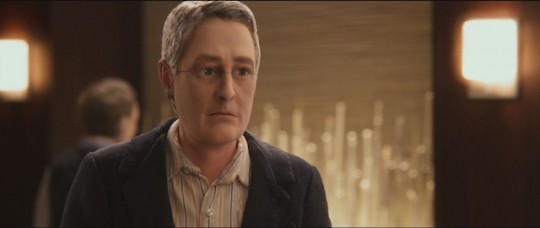Plot points from the entirety of Anomalisa will be discussed below; if you would prefer to see it sans spoilers, please skip this and check back in six months or so once it's on Netflix or whatever, since it's probably not playing in a theater near you right now and, I'm guessing, isn't going to.
The decision to make a film using puppets and stop-motion animation is not one to be taken lightly, as the process is fastidious and slow-paced. But it's one that pays off handsomely in Charlie Kaufman's latest feature, Anomalisa, about a man slowly going insane.
Michael Stone (David Thewlis) has a problem: everyone he sees has the same facial features and the same voice (Tom Noonan). We get a hint as to the nature of his disorder from the name of the hotel in which he's staying (Fregoli) ahead of a speech he's to give at a conference on customer service. "Fregoli syndrome" is the "delusional belief that one or more familiar persons, usually persecutors following the patient, repeatedly change their appearance."
Knowing that, we understand why everyone that Stone encounters or hears—random people in a hotel lobby, waitresses, a long-lost lover, even his wife and son—sound more or less the same to his ears and look the same to his eyes, subtle shifts to hair and clothing notwithstanding. Originally conceived as a radio play, more or less, the film's use of puppets to mimic Stone's psychosis is a far more elegant solution than, say, dubbing Noonan's vocals over other actors or expecting him (and background artists wearing Noonan masks) to play every role. There's an androgyny to the puppets' faces that the famous character actor simply couldn't mimic.
Stone's delusion combined with the symmetry of every face around him heighten his obvious isolation from the world: the delusion is a sort of living prison from which there is no escape. For a brief moment moment he finds release in the form of Lisa (Jennifer Jason Leigh), whose face and voice are both her own. But the reprieve doesn't, maybe can't, last. And her reversion to the Fregoli norm prompts a breakdown. During his speech he begins to unravel ("I have no one to talk to, I have no one to talk to, I have no one to talk to ... I'm sorry, I don't mean to burden you, I just don't what else to do") before marching around the stage and spouting liberal platitudes ("The world is falling apart! The president is a war criminal! America's going down the tubes and you're talking about goddamn intelligent design. You've intentionally destroyed the public education system because it's easier to manipulate dumb workers and soldiers").
Despite the fact that this movie is being released in 2015/2016, "the president" he is referring to is George W. Bush, given that we see a picture of Dubya behind the desk of a hotel employee earlier in the film and the date on a letter (combined with a subsequent conversation with its writer) places the film midway through his second term. I'll admit to being vaguely annoyed by this the first time I saw Anomalisa—I try desperately hard to keep my feelings about politics and art (and artists) separate, but this, coming seven years into Obama's presidency, felt like a needless provocation.* One can be mistaken for associating Kaufman with the protagonists of his films, and this felt very much like a speech from the heart.
On second viewing, though, I couldn't help but wonder if Kaufman, by putting the words into the mouth of a man so obviously bedeviled by mental issues and struggling with his sense of isolation, was trying to say more about those who couldn't mentally process the indignity of a Bush presidency. If it wasn't, perhaps, a veiled critique of those who thought of the nation's voters as mindless, faceless, interchangeable drones. Probably not. Who knows. Either way, I felt more pity than annoyance the second time around.
And that, perhaps, is the genius of Anomalisa: its ability to inspire pity for unpleasant puppets—and their puppeteers.
*Microaggressions are real, man.
